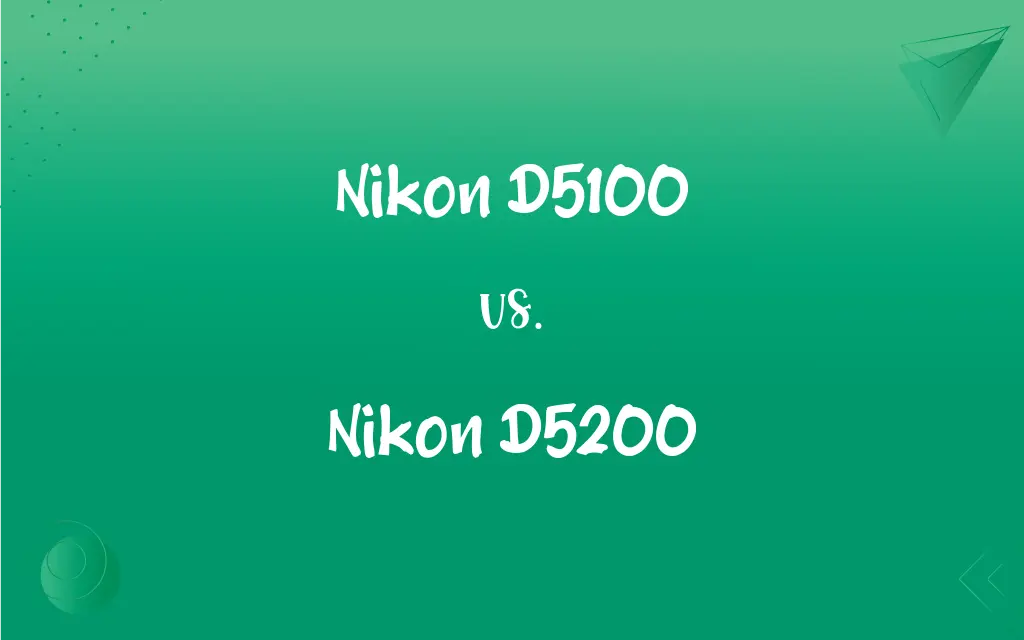Nikon D5100 vs. Nikon D5200: What's the Difference?
Edited by Aimie Carlson || By Janet White || Published on March 18, 2024
Nikon D5100: 16.2MP, vari-angle LCD, beginner-friendly. Nikon D5200: 24.1MP, improved AF system, better for advanced users.

Key Differences
The Nikon D5100 and Nikon D5200 are both DSLR cameras designed for amateur photographers, but they cater to slightly different levels of expertise. The D5100, with its 16.2 megapixel sensor, offers quality images suitable for those stepping into DSLR photography. In contrast, the D5200 boasts a 24.1 megapixel sensor, providing higher resolution images for those ready to delve a bit deeper into photography.
One of the key features of the Nikon D5100 is its vari-angle LCD screen, which facilitates shooting from various angles, making it versatile for beginners. The Nikon D5200 also features a vari-angle screen but adds an enhanced autofocus system with 39 points, compared to the D5100's 11-point AF system, allowing for more precise focusing, especially in dynamic shooting situations.
In terms of performance, the Nikon D5100 provides a solid foundation with good low-light capabilities and a user-friendly interface. Meanwhile, the Nikon D5200 steps up the performance with a better image processor, resulting in faster operation and improved image quality, particularly in terms of color depth and dynamic range.
For video enthusiasts, both the Nikon D5100 and D5200 offer Full HD video recording. However, the D5200 edges out its predecessor by providing a higher frame rate option and improved video autofocus, catering to users looking to produce more refined video content.
The Nikon D5100 is often praised for its ease of use, making it an excellent choice for beginners, while the Nikon D5200, with its advanced features and higher resolution, is better suited for those with more experience or those who demand more from their photography equipment.
ADVERTISEMENT
Comparison Chart
Resolution
16.2 megapixels
24.1 megapixels
Autofocus System
11-point AF system
39-point AF system
Image Processor
EXPEED 2
EXPEED 3
ISO Range
100-6400 (expandable to 25600)
100-6400 (expandable to 25600)
Continuous Shooting
4 frames per second
5 frames per second
ADVERTISEMENT
Video Resolution
1080p at 30fps
1080p at 60i/50i
Screen
3-inch vari-angle LCD
3-inch vari-angle LCD
Color Depth
Slightly lower than D5200
Higher color depth
Dynamic Range
Good
Improved over D5100
User Interface
Beginner-friendly
Slightly more complex, suitable for advanced
Nikon D5100 and Nikon D5200 Definitions
Nikon D5100
User-friendly interface ideal for beginners.
Learning photography has been a breeze with my Nikon D5100's easy-to-navigate menus.
Nikon D5200
Features an advanced 39-point autofocus system.
Capturing fast-moving sports action was effortless with my Nikon D5200's autofocus system.
Nikon D5100
A versatile entry-level DSLR camera.
I took my Nikon D5100 on the hiking trip and captured stunning landscape photos.
Nikon D5200
A DSLR that offers a significant leap in image resolution.
The Nikon D5200's 24.1MP sensor captured the intricate details of the butterfly's wings perfectly.
Nikon D5100
Delivers solid performance in low light conditions.
The Nikon D5100's performance in dimly lit settings made it perfect for my indoor event photos.
Nikon D5200
Boasts superior image processing with the EXPEED 3.
My Nikon D5200 handled the high-contrast scene flawlessly, thanks to its EXPEED 3 processor.
Nikon D5100
Known for its swivel LCD screen, making angled shots easier.
Using the Nikon D5100's vari-angle screen, I snapped a creative overhead shot at the concert.
Nikon D5200
Provides enhanced video capabilities for aspiring filmmakers.
Shooting my short film on the Nikon D5200, I appreciated the smooth video autofocus and high frame rates.
Nikon D5100
Offers excellent image quality for its class.
The Nikon D5100 surprised me with the clarity and detail of my night photography.
Nikon D5200
A step up for enthusiasts seeking more control and quality.
The Nikon D5200 has been my reliable companion for exploring more advanced photography techniques.
FAQs
What sets the Nikon D5200 apart from the D5100?
The D5200 offers higher resolution, an advanced AF system, and better image processing.
Is the Nikon D5200 good for video recording?
Yes, it offers improved video features including higher frame rates and autofocus in video mode.
Do both cameras have the same ISO range?
Yes, both have an ISO range of 100-6400, expandable to 25600.
Can the Nikon D5100 shoot video?
Yes, it can record Full HD 1080p video.
Which camera has a better screen?
Both have a 3-inch vari-angle LCD screen, but the D5200's may offer slightly better resolution.
How does battery life compare between the D5100 and D5200?
Battery life is similar, but actual performance can vary based on usage patterns.
What are the video frame rate capabilities of the D5200?
The D5200 can record 1080p video at 60i/50i, offering smoother motion compared to the D5100.
What is the Nikon D5100 best known for?
Its versatility and user-friendly features make it ideal for beginners.
What type of photographer is the D5100 aimed at?
It's aimed at beginners and hobbyists looking for a reliable entry-level DSLR.
Can I use my old Nikon lenses with the D5100 and D5200?
Yes, both cameras are compatible with a wide range of Nikon F-mount lenses.
Who should consider buying the Nikon D5200?
It's best suited for intermediate photographers or those needing higher resolution and performance.
Is there a significant weight difference between the two cameras?
The weight difference is minimal, with both cameras being lightweight and portable.
Are these cameras good for low-light photography?
Yes, both perform well in low light, with the D5200 having a slight edge due to its newer image processor.
Does the Nikon D5200 have built-in GPS or Wi-Fi?
No, it does not have built-in GPS or Wi-Fi, but these can be added through external accessories.
How do the autofocus systems of the D5100 and D5200 compare?
The D5200 has a more advanced 39-point AF system, compared to the D5100's 11-point system.
What's the main reason to choose the D5200 over the D5100?
Choose the D5200 for its higher resolution, better autofocus, and improved processing capabilities, especially if you're advancing in photography skills.
What is the image processing difference between the two?
The D5200 uses the newer EXPEED 3 processor, providing faster processing and better image quality.
What kind of memory card do I need for the D5100?
It uses SD, SDHC, or SDXC memory cards.
How can I share photos from my D5100?
Photos can be transferred via a memory card or by connecting the camera to a computer.
Can the Nikon D5200 handle sports photography?
Yes, its 39-point AF system and 5 fps shooting make it suitable for action and sports photography.
About Author
Written by
Janet WhiteJanet White has been an esteemed writer and blogger for Difference Wiki. Holding a Master's degree in Science and Medical Journalism from the prestigious Boston University, she has consistently demonstrated her expertise and passion for her field. When she's not immersed in her work, Janet relishes her time exercising, delving into a good book, and cherishing moments with friends and family.
Edited by
Aimie CarlsonAimie Carlson, holding a master's degree in English literature, is a fervent English language enthusiast. She lends her writing talents to Difference Wiki, a prominent website that specializes in comparisons, offering readers insightful analyses that both captivate and inform.
































































